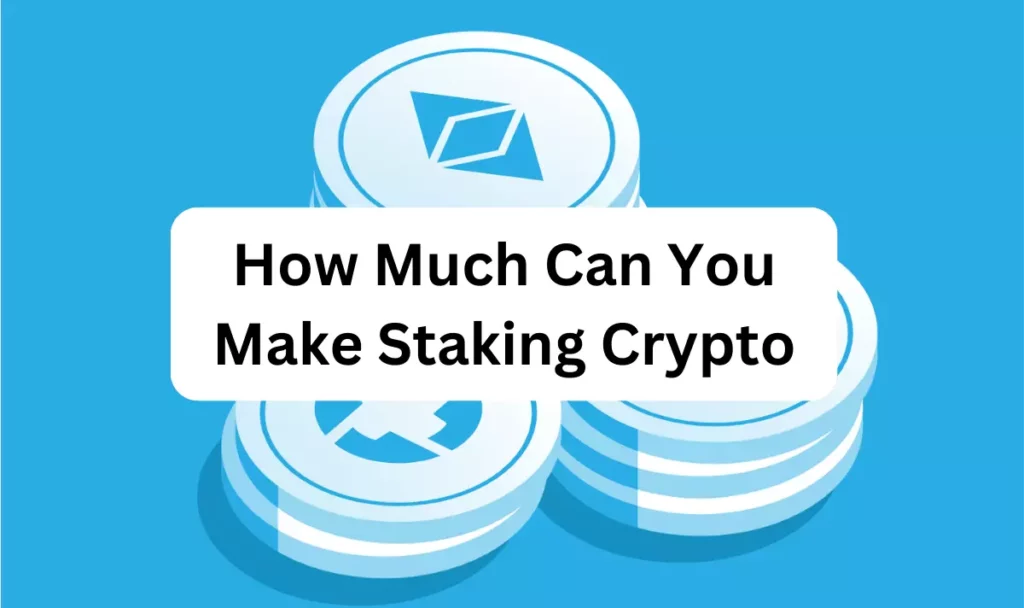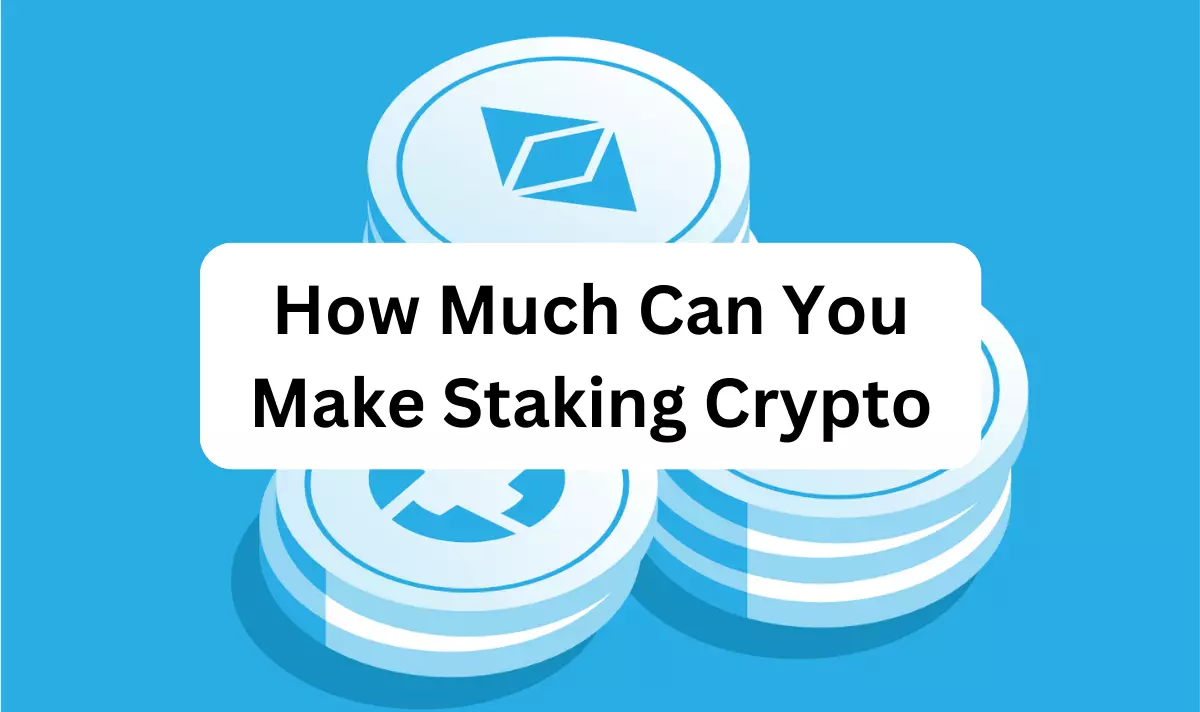
Introduction
When it comes to staking crypto, the burning question on everyone’s mind is, “How much can I make?” As someone who has explored the world of crypto staking, I understand the curiosity surrounding potential earnings. The truth is the amount you can make staking crypto depends on various factors, such as the token’s annual percentage yield (APY), network participation, and market conditions. In this guide, I will delve into these factors, provide real-life examples, and equip you with the knowledge to estimate your staking earnings accurately. Let’s uncover the exciting world of crypto staking and discover the potential rewards awaiting you.
Further reading suggestion for you: How much can you make Mining Crypto
Content
Calculating Potential Earnings

Calculating potential earnings is crucial when considering crypto staking as an investment strategy. By understanding how to estimate your staking profits, you can make informed decisions and maximize your returns. I will explain the key factors to consider and provide practical examples to help you calculate your potential earnings accurately.
1. Estimating Staking Rewards with APY and Token Holdings
To calculate potential earnings, consider the Annual Percentage Yield (APY) and the number of tokens you plan to stake. The APY represents the expected annual return on your staked tokens. Here’s how you can estimate your earnings:
- Determine the APY: Research the staking platform or network you’re using and find the APY offered. This percentage represents the annual return you can expect on your staked tokens.
- Calculate Token Rewards: Multiply your staked token holdings by the APY to determine the annual token rewards. For example, if you stake 1,000 tokens and the APY is 10%, your annual reward would be 100 tokens.
2. Case Study
Calculating Earnings with Real-World Examples: To illustrate the process, let’s consider a hypothetical scenario:
- Staking Platform X offers an APY of 12% on a specific token.
- You decide to stake 500 tokens of that cryptocurrency.
- Calculating annual rewards: 500 tokens x 12% = 60 tokens.
- Monthly earnings: 60 tokens / 12 months = 5 tokens per month.
- Converting to USD: If the token’s current value is $10, then your monthly earnings would be $50.
Remember that the actual value of the token may change, affecting the USD equivalent of your earnings. It’s essential to stay updated on market conditions.
3. Tools and Calculators for Staking Profitability Assessment
Several online tools and calculators can simplify the process of estimating staking earnings. These tools consider variables like APY, token holdings, and staking duration. Some popular calculators include APEX Staking Calculator, Staking Rewards, and CryptoCompare’s Staking Calculator. Utilizing these tools can assist in making informed decisions.
By calculating potential earnings accurately, you can assess the viability of staking as an investment strategy. Remember to consider the APY, token holdings, and duration when estimating earnings. Additionally, take advantage of staking calculators available online to simplify the process. Understanding your potential earnings empowers you to make informed decisions and maximize your profits through crypto staking.
Maximizing Staking Profits

To maximize your staking profits and achieve the best returns on your crypto investments, it’s essential to implement effective strategies. I will share valuable insights and techniques to help you optimize your staking earnings. By following these strategies, you can enhance your profitability and make the most of your staking endeavors.
1. Choosing the Right Staking Asset and Network
Selecting the right staking asset and network is crucial for maximizing your profits. Consider the following factors:
- Research and Analysis: Conduct thorough research on different staking assets and networks. Analyze their historical performance, staking rewards, and long-term viability.
- Diversification: Diversify your staking portfolio by investing in multiple assets and networks. This approach minimizes the risk of potential losses and maximizes your chances of earning higher rewards.
2. Optimal Staking Strategies
Delegating vs. Running a Validator Node: To optimize your staking profits, you must choose the most suitable staking strategy:
- Delegating: By delegating your tokens to a trusted validator node, you can participate in staking without the technical complexities of running a node. This strategy allows you to earn staking rewards while keeping your tokens secure.
- Running a Validator Node: If you possess technical expertise and a sufficient stake, running your validator node can lead to higher rewards. However, it requires technical knowledge, infrastructure setup, and continuous monitoring.
3. Compound Interest and Reinvestment Strategies
Maximize your staking profits through the power of compound interest:
- Reinvesting Rewards: Instead of immediately cashing out your staking rewards, consider reinvesting them. By retaking or compounding your rewards, you can accelerate the growth of your staked tokens and generate higher earnings over time.
- Regularly Review and Adjust: Continuously monitor your staking performance and adjust your strategies accordingly. Analyze the market conditions, network upgrades, and changing APYs to make informed decisions and maximize your returns.
4. Exploring Yield Farming and Liquidity Mining Opportunities
Yield farming and liquidity mining present additional opportunities to boost your staking profits:
- Yield Farming: By leveraging decentralized finance (DeFi) protocols, you can earn additional rewards by providing liquidity to liquidity pools. Explore reputable platforms that offer yield farming opportunities and carefully assess the associated risks.
- Liquidity Mining: Some networks incentivize liquidity providers by distributing additional tokens to those who contribute liquidity. By participating in liquidity mining programs, you can increase your staking profits.
To maximize your staking profits, it’s crucial to choose the right staking asset and network, implement optimal staking strategies, leverage compound interest through reinvestment, and explore additional opportunities like yield farming and liquidity mining. By incorporating these strategies into your staking journey, you can enhance your profitability and make the most of your crypto investments.
Conclusion
The world of staking crypto offers an enticing opportunity to earn passive income. Throughout this guide, I have provided insights into the factors that determine your potential earnings from staking, including the token’s APY, network participation, and market conditions. While the exact amount you can make may vary, it’s crucial to approach staking with a realistic perspective and a thorough understanding of the risks involved. By carefully considering these factors, conducting research, and utilizing tools and calculators, you can estimate your staking earnings and make informed decisions. Remember, successful staking requires diligence, adaptability, and a long-term perspective. So, dive into the exciting realm of crypto staking, embrace the possibilities, and enjoy the journey of earning from your crypto investments.
u003cstrongu003eAre staking returns guaranteed, or can they fluctuate?u003c/strongu003e
Staking returns are not guaranteed and can vary based on several factors. The token’s APY, market conditions, network participation, and token price fluctuations can all impact your staking earnings. It’s important to understand that staking involves certain risks and rewards that can change over time.
u003cstrongu003eHow often are staking rewards distributed?u003c/strongu003e
The frequency of staking reward distributions depends on the specific blockchain network and staking platform. Some networks distribute rewards daily, while others do so on a weekly, monthly, or longer basis. Familiarizing yourself with the staking platform’s reward distribution schedule to manage your expectations is essential.
u003cstrongu003eCan I withdraw my staked tokens at any time?u003c/strongu003e
Staking typically involves locking up your tokens for a specific period. During this time, your tokens are committed to securing the network and earning rewards. Most networks have a lock-up period, ranging from a few days to several months. It’s important to consider the lock-up period before staking and understand that early withdrawal may result in penalties or loss of rewards.
u003cstrongu003eAre staking rewards affected by network fees?u003c/strongu003e
Yes, network fees can impact your staking rewards. When claiming or transferring your staking rewards, you may need to pay transaction fees. These fees can vary depending on network congestion and gas prices. It’s essential to consider these fees when estimating your overall staking earnings.
u003cstrongu003eCan staking rewards be reinvested automatically?u003c/strongu003e
Automatic reinvestment of staking rewards depends on the staking platform or wallet you use. Some platforms offer the option to reinvest your rewards, compounding your earnings over time automatically. However, not all platforms provide this feature, so it’s important to check the platform’s capabilities or manually reinvest your rewards if desired.

Johnny is a finance blogger who has been blogging for years. He’s familiar with everything that goes into it, and loves to share his knowledge with others.













